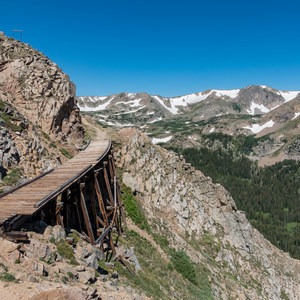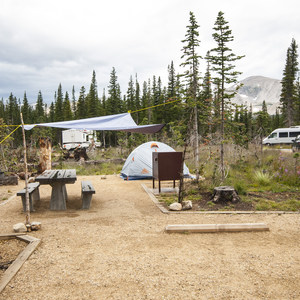The trail to Crater Lakes begins at the East Portal, also known as the Moffat Tunnel. This impressive example of human engineering was first envisioned by David Moffat, who relocated to the booming mining town of Denver in 1860. The Union Pacific Railroad was trying to find the best way to pass through the Continental Divide over the Rocky Mountains, and the company settled on southern Wyoming's more manageable terrain. Later, Moffat decided to build a direct route from Denver to Salt Lake City across Colorado via a tunnel through the mountain range. Though it did not come to fruition during Moffat's lifetime (he died on March 18, 1911), his business partners and associates kept his dream alive, and the tunnel's construction received financial backing on June 11, 1923. The construction camps established at the site included schools, hospitals and recreation facilities. Some of the buildings still remain and can be seen at the East Portal Trailhead.
The first freight train made its way through the finished tunnel on February 24, 1928. The Moffat Tunnel reaches 6.21 miles in length and took four years to complete at a total cost of $15.6 million. The tunnel shaved an impactful 23 miles off the previous route, and it is still used today by Union Pacific to transport freight across Colorado.
After marveling at the history this trailhead provides, continue through the forest, following along South Boulder Creek, gaining little elevation until the cut off to Crater Lakes. There are two trail junction signs on the way that will indicate how much farther the Crater Lakes Trailhead is, but the actual sign at the junction is typically buried beneath the snow during the winter months. If there aren't any tracks to the right off the main trail, look for a tree with a blue paint spot on it at about 2 miles from the parking area. The path is further marked by brown paint spots on a few trees. It is highly recommended to travel with a GPS track to follow to avoid taking a difficult route to the lakes; there is an elevation change of about 1,000 feet, and some tracks may lead off the true trail.
There are two lower Crater Lakes and one upper Crater Lake that can all be reached from this trail, though, the upper lake is a steep climb.


































Comments
Sign In and share them.